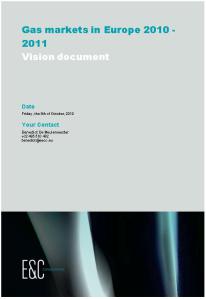The past month has been a bit low in blogging activity, due to my being busy creating a report on the European gas market. Research of supply and demand figures brought me some surprising insights. You can read an extract of the report by clicking on the link below. Please read the executive summary of the report below. Contact me at benedict@eecc.eu if you want to receive a full copy of the report.
Executive summary
- 'Energy can only get more expensive', is a common belief among energy buyers. However, we have recently seen that natural gas prices remained relatively low, even when the economic activity picked up. Oil prices rose, so the gas prices on the Hubs became structurally lower than oil-indexed gas prices.
- The biggest natural gas reserves in the world are to be found in the Middle-East and not in Russia. However, the Middle-East are currently only the world's fourth largest producer of natural gas, meaning that huge reserves are untapped. Gas production in gas reserves giants Qatar and Iran has started to rise exponentially in recent years. This explains the presence of excess gas volumes in the world markets.
- The US has increased its production of natural gas by 16% due to the development of shale gas. In 2009 they were the world's biggest producer of natural gas, bigger than Russia. We have always known that beyond conventional gas reserves, a lot of gas was trapped in this shale layer. Only, it was always thought that it was impossible to produce gas from these layers without excessive costs. Recently production techniques have been improved, and the energy companies claim that it is now possible to produce shale gas at a cost that is lower than the production of conventional gas. The possibility to economically produce shale gas boosts the gas reserves of the world.
- Shale gas production has already had an impact on gas prices, as it made more LNG available to the European market as less was needed in the US. If the US continues to expand its gas production, it might even start exporting LNG. There is also potential for shale gas production in Europe and in China. If all this shale gas production is developed, the world's gas supply situation will look completely different. However, this whole shale gas development could be turned back due to environmental impact of the shale gas production. It is too early to decide what the further development will be.
- As of 2011, the Nord Stream gas pipeline will bring additional gas from Russia to Germany, 22,5 billion m³ of capacity in 2011 and 45 billion m³ in 2012.
- Natural gas demand in Western-Europe peaked in 2004 and then started to fall. This is contrary to popular belief that energy consumption is continuously growing.
- Although the growth rate of power consumption is slowing down, it is still growing. Deployment of electric cars would speed up this growth of electricity demand. Most of these extra MWh's of electricity are now produced from renewable energy sources. But the growth of demand is faster than the growth of renewable. This means that extra power plants will need to be built. Plans to shut down nuclear power plants in countries like Germany, Belgium, the Netherlands and UK have been turned back, meaning that fewer power plants will need to be built. How much of the new power plants will be gas-fired will depend on whether new nuclear and (clean) coal-fired power plants can be developed. Which plants will be built is subject to political decisions. It is therefore madness to try to predict how much extra gas will be needed for new gas-fired power plants.
- A multitude of factors will determine whether gas supply will continue to grow and/or gas demand will continue to fall. Therefore, it is impossible to predict whether the current situation of over-supply will continue or not. The important news is that it is not unthinkable that we might see some decades ahead with abundant natural gas available to our markets, resulting in lower gas and electricity prices. Therefore, corporate energy strategies based on the adagio that energy can only become more expensive, should be adapted. Guidance on how to do this can be found in the conclusion of this report.

